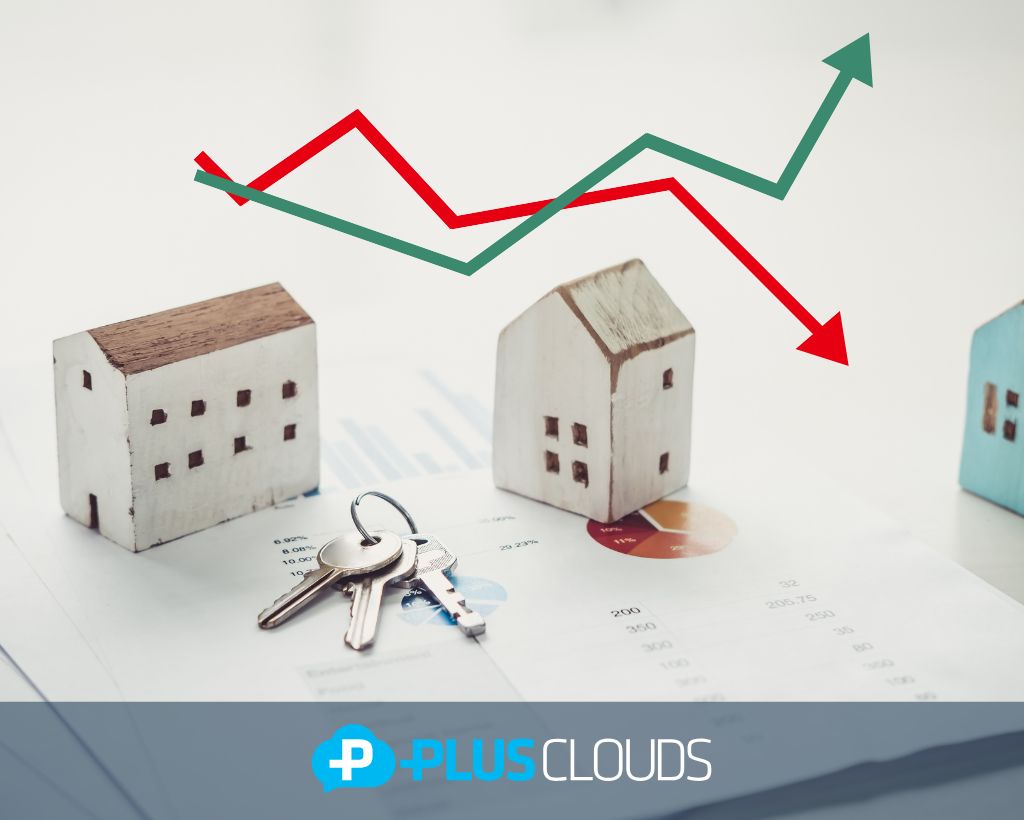
جرب خدمة PlusClouds إيجلت واكتشف فرص وعملاء محتملين عالي الجودة في مجال الأعمال بين الشركات بدعم الذكاء الاصطناعي


في السنوات الأخيرة، بدأت الذكاء الاصطناعي (AI) وتعلم الآلة (ML) تحدث ثورة في قطاع العقارات، من خلال مجالات مثل توقع الأسعار، تحليل الطلب وإدارة المحفظة. ومع ذلك، لا تقتصر هذه التقنيات على فهم البيانات الحالية، بل تعد بإمكانية التنبؤ بالسيناريوهات الحرجة المستقبلية. أحد هذه السيناريوهات هو فقاعات العقارات: وهي حالات أزمات مالية تتضخم فيها الأسعار بشكل مصطنع نتيجة اختلال توازن العرض والطلب، ثم تنفجر فجأة بانخفاض حاد. فهل يمكن للذكاء الاصطناعي حقًا أن يتوقع هذه الفقاعات؟ هذا هو السؤال الذي نسعى للإجابة عليه.
فقاعة العقارات هي ظاهرة تحدث عندما ترتفع أسعار المساكن بشكل مصطنع بعيدًا عن الأسس الاقتصادية. تغذي هذه الزيادة عادةً عوامل مثل سلوك المستهلك، الاستثمارات المضاربة، القروض الرخيصة، والافتقار إلى التنظيم. تصبح الأسعار غير مستدامة في مرحلة ما، وتظهر الانخفاضات المفاجئة ("الانفجار"). تعتبر أزمة 2008 مثالًا حادًا على ذلك. يمكن أن يغير التنبؤ المسبق بمثل هذه السيناريوهات الكثير بالنسبة للمستثمرين وصناع السياسات.
لم يكن من الممكن التنبؤ بالعديد من الأزمات الاقتصادية باستخدام النماذج الاقتصادية التقليدية. تعتمد هذه النماذج عادةً على الافتراضات الخطية، وتعمل مع بيانات ثابتة، وتتجاهل العلاقات المعقدة بين جميع المتغيرات. بينما تنشأ فقاعات السكن من تفاعل علم النفس الاجتماعي، الاقتصاد السلوكي، والهندسة المالية. لذلك، كانت هناك حاجة إلى تحليلات أكثر تعقيدًا وذات أبعاد متعددة وكثيفة البيانات. وهنا يأتي دور الذكاء الاصطناعي.
الميزة الأهم للذكاء الاصطناعي هي قدرته على التعرف على العلاقات والارتباطات والأنماط بين العديد من المتغيرات المعقدة. يمكن استخدام هذه القدرة لاكتشاف "الشذوذ" في سوق العقارات.
يمكن لخوارزميات تعلم الآلة تحليل التغيرات في أسعار المساكن على مر الزمن وتحديد الانحرافات عن المتوسط ("حالات الشذوذ"). يمكن اختبار ما إذا كانت هذه الانحرافات تشير إلى ظهور فقاعات قد تشهد زيادة هادئة ثم انفجار مفاجئ.
يمكن تدريب نماذج التعلم تحت الإشراف باستخدام بيانات أزمات مثل أزمة 2008. بمعنى أن النموذج يتم تدريبه باستخدام أمثلة توضح أن "هذه البيانات تشير إلى وجود فقاعة". يمكن البحث عن إشارات مماثلة في الأسواق الحالية.
إذا اعتبرنا أن الفقاعات لا تبدو دائمًا بنفس الشكل، قد يكون التعلم بدون إشراف أكثر مرونة. على سبيل المثال، قد تكون الانحرافات غير العادية في نسبة أسعار المساكن إلى عائدات الإيجارات علامات محتملة على وجود فقاعة.
(الرسم البياني يظهر معدلات تخلف الرهن العقاري بين عامي 2004 و2010.
المناطق المعينة بالدوائر الحمراء قد تكون نقاط تم تحديدها من قبل الذكاء الاصطناعي على أنها "زيادة غير طبيعية".
كان بإمكان هذه الإشارات المبكرة أن تشير إلى اقتراب انهيار السوق.)*
تمثل أزمة 2008 أزمة انفجرت نتيجة تعقيد الأوراق المالية المرتبطة بالعقارات، والتوزيع غير المنظم للقروض العقارية، وزيادة مضاربة سريعة على مستوى السوق. عند تحليل بيانات هذه الفترة، كانت هناك العديد من "الشذوذ" مثل الزيادة غير المتناسبة في أسعار المساكن مقارنة بالعائدات، والارتفاع الحاد في مستويات الاقتراض الرهن العقاري، وانخفاض عائدات الإيجارات مقارنة بالأسعار.
لو كان من الممكن إجراء توقعات أسعار باستخدام أساليب تعلم عميقة مثل LSTM خلال هذه الفترة، لكانت الانحرافات غير الطبيعية قد قدمت إشارات تحذير مبكرة. وبالمثل، يمكن تسليط الضوء على الاتجاهات السلوكية مثل "أسعار المنازل ترتفع" و"الجميع يشتري المنازل" من خلال تحليل وسائل التواصل الاجتماعي أو تحليل المشاعر الإخبارية.
بالإضافة إلى ذلك، فإن تسارع الميل نحو فئة القروض السيئة المعروفة باسم "الرهن العقاري الثانوي" في الولايات المتحدة قد يشير إلى تدهور جودة محفظة القروض من خلال نماذج التعلم تحت الإشراف. من خلال دمج هذه الإشارات، كان من الممكن الوصول إلى مستوى إنذار معين في بعض الأسواق قبل أزمة 2008.
يمكن أن نطرح هنا السؤال: إذا كانت هذه النماذج موجودة بالفعل في ذلك الوقت، هل كانت ستمنع الأزمة بالكامل؟ ربما لا، ولكن على الأقل يمكن أن تقلل من تأثيرها مع تنظيمات أكثر صرامة وتحركات سياسية مبكرة للحد من الأضرار.
تعتبر أنواع البيانات التالية حاسمة لتوقع الفقاعات:
توقع السلاسل الزمنية: ARIMA، Prophet، LSTM
اكتشاف الشذوذ: Isolation Forest، One-Class SVM
نماذج التصنيف: XGBoost، Random Forest، الشبكات العصبية
تحليل اللغة الطبيعية وبيانات التواصل الاجتماعي: BERT، نماذج تحليل المشاعر
-أنظمة التحذير المبكر لصناع السياسة: أنظمة تُعلم البنوك المركزية أو البلديات بالمناطق الساخنة بشكل مفرط في السوق.
-رؤى للمستثمرين: تحديد المناطق التي تحمل علامات على وجود فقاعات لمتعهدي المحفظة.
-تقييم مخاطر القروض: تقييم العقارات في المناطق عالية المخاطر بشكل أكثر دقة من قبل البنوك.
يتطور قطاع العقارات بسرعة بسبب تأثير التحول الرقمي وتزداد المنافسة يومًا بعد يوم. في هذه البيئة الديناميكية، يعتبر الوصول إلى العملاء المناسبين وتحسين عمليات البيع أمرًا حيويًا للنجاح. تقدم أداة LeadOcean المدعومة بالذكاء الاصطناعي من PlusClouds مزايا هامة لمهنيي العقارات في هذا المجال.
LeadOcean هي أداة تعتمد على الذكاء الاصطناعي تحلل موقعك على الويب وتحدد العملاء المحتملين الأكثر توافقًا مع الخدمات التي تقدمها. من خلال مطابقة احتياجات العملاء مع الخدمات التي تقدمها، تحدد أفضل المرشحين لك.
تحليل البيانات الذكي: يقوم LeadOcean بتحليل البيانات المتاحة على الإنترنت، مما يساعد في التعرف على العملاء المحتملين المناسبين لقطاعك. من خلال ذلك، يمكنك التركيز على المشترين المهتمين حقًا.
تتبع العملاء تلقائيًا: يساعد في تحليل سلوك المشترين المحتملين، مما يمكنك من تحديد العملاء القريبين من اتخاذ قرار شراء عقار.
التسويق المستهدف: من خلال الوصول إلى الأشخاص الذين يتوافقون مع المعايير التي تحددها، يعزز فعالية حملاتك الإعلانية ويسمح لك بالوصول إلى الأشخاص المناسبين في الوقت المناسب.
LeadOcean هو أداة قوية تسهم في تسريع عمليات اكتساب العملاء للمهنيين العاملين في قطاع العقارات، وزيادة المبيعات، وتحسين استراتيجيات التسويق. بمساعدة حلولها المدعومة بالذكاء الاصطناعي، تساعدك على التميز في هذا القطاع شديد التنافس.
يمتلك الذكاء الاصطناعي إمكانات كبيرة في توقع الشذوذ وفقرات الأسعار المحتملة في أسواق العقارات. ومع ذلك، يجب أن تكون أهداف هذه الأنظمة ليست خلق حالة من الذعر، بل تقديم معلومات تحليلية في الوقت المناسب لصناع القرار. في المستقبل، قد تلعب أنظمة التحذير المبكر هذه دورًا أساسيًا في الحفاظ على الاستقرار المالي.
قد تكون متابعة آثار الأزمات أحيانًا أفضل طريقة لمنع أزمات جديدة. يمكن أن يضيء الذكاء الاصطناعي الطريق لنا في هذا الاتجاه.